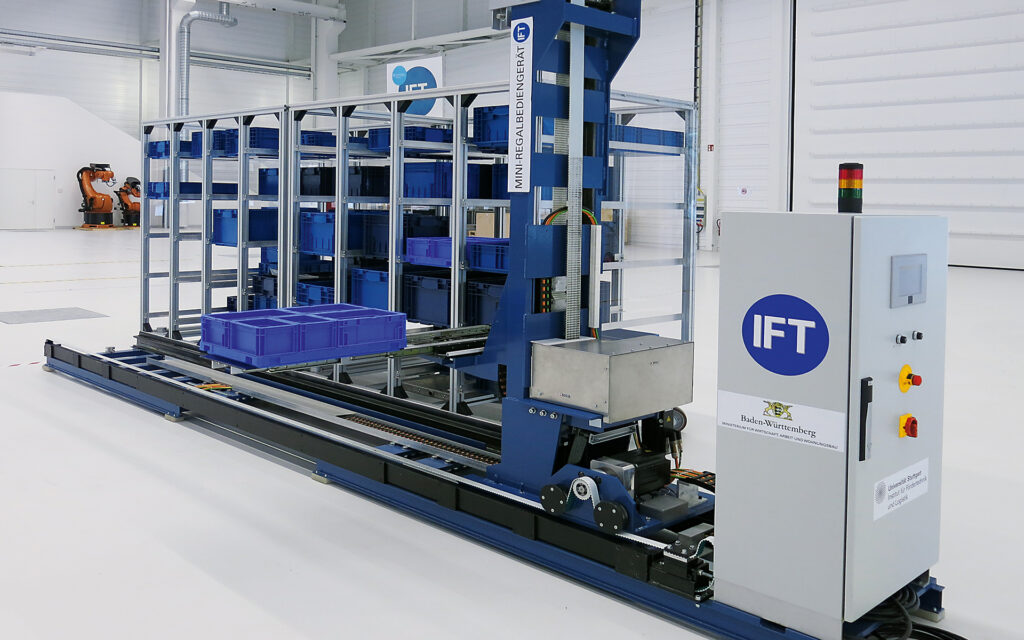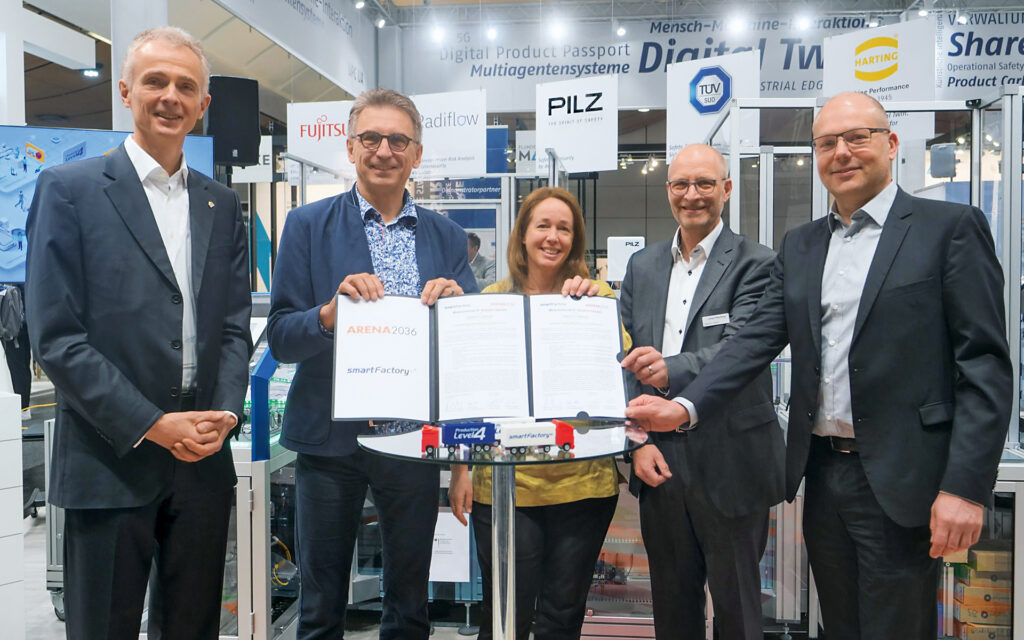Where the future is concerned, Pilz not only looks to exchange with customers, but also works intensively with research initiatives. But the secret recipe for successful research is not digitisation …
For Bernd Neuschwander, Wednesday is “ARENA day”. That’s when he moves from his actual workplace in the “Advanced Development” department at Pilz, to the “ARENA2036” at Stuttgart University. On site, in the large hall at the research campus, between robot cells and virtual reality workstations, an engineer from the production technology department of a large automotive supplier comes up to Bernd Neuschwander: “You make safe automation! We have an idea for an automated guided vehicle system in our production. Will you give us your opinion on it?”
Pilz conducts research in ARENA2036
ARENAARENA stands for Active Research Environment for the Next Generation of Automobiles. Resource-efficient, competitive production models are intended to emerge by the year 2036, the 150th anniversary of the car. Pilz has been a member of ARENA2036 for nine years, actively working on a variety of projects. “In ARENA2036 we discuss future trends and new production methods, and then immediately test them for practicality within projects”, Neuschwander explains. “Direct exchange between technicians, engineers and developers is the key benefit – no hierarchy, just deal directly.”

For example, Bernd Neuschwander collaborates in the fluid production project, which is concerned with the development and implementation of a human-centred, cyber-physical production concept. “It sounds abstract, but in practice it means that all production plants are initially broken down into flexible modules. These can then be combined to form dynamic units, entirely according to need.
The human plays a key role, as an active shaper of their production environment”, Neuschwander explains. The vision: platforms on which cars are assembled and configured. These platforms move freely within the hall. Other platforms containing supplier parts or necessary assemblies are docked and undocked as part of the production process. Human and robot work together, without a safety fence.
Can machinery safety be digitised?
Adaptability also plays a major role in the project SDM4FZI. The solution approach: to define production exclusively via software and therefore make it dynamically adjustable. In this way, the project partners wish to create a purely digital production factory, in order to achieve maximum adaptability. “The safety of the machinery must also be part of this comprehensive software”, says Matthias Schweiker, a colleague of Bernd Neuschwander, who is researching the future of machinery safety in this project, for Pilz.
“We are working on tool-supported CE conformity, in other words the digitisation of machinery safety, networking and security, and on developing the digital administration shell for safety parameters.” The team has been working in defined work packages since October 2021. The main focus at the moment is in creating standards. The project will be completed at the end of March 2024.

Machinery safety in real-time
The Smart Factory KL in Kaiserslautern is the other key research partner for Pilz. Here too, Pilz is collaborating on the automation solutions of the future – including safety. To ensure that the protection of human and machine remains guaranteed at all times.
With regard to safety, dynamic situations in future production environments must be checked and enabled in real-time. The keyword here is “Real-time safety”. In the future it’s conceivable that various machines – or general assets – will share safety devices. The term here is “Shared safety”, a concept that Pilz is testing along with its partners in the Smart Factory KL.
ARENA2036 and Smart Factory KL strengthen their cooperation
ARENA2036 and Smart Factory KL wish to work together closely in future: The first joint project, Project ARENA‑X, is developing a demonstration and test environment for the use of data spaces. In these data spaces, all companies participating in the value-added process are to be able to exchange data safely.
“The data-space-based environment serves humans: it creates the opportunity to demonstrate, try out and test. New knowledge for safe automation can emerge as a result, completely in the spirit of Manufacturing‑X”, says Susanne Kunschert, Managing Partner of Pilz. Kunschert is also a member of the board of ARENA2036. “Data spaces are the solid foundation for digital collaboration. They can be connected, and combine the knowledge of available services from a multitude of production environments.”

Data space creates degrees of freedom
In Kaiserslautern, where Smart Factory KL is based, a model truck is being manufactured in a shared production, so far at three locations. In the research scenario, customers can assemble a lorry via a product configurator. In future, a production model from Pilz, which is located in ARENA2036 in Stuttgart, will be part of the production architecture, as it is incorporated into the Gaia‑X data space at the Smart Factory KL in Kaiserslautern.
For example, the configurator offers the option of “Yellow driver’s cab”. Once clicked, production in ARENA2036 should start. The first step is to “produce” the driver’s cab in Pilz yellow in the 3D printer; it then undergoes quality control using an AI algorithm. It is then ready to transport to Kaiserslautern, where it can be installed in the model lorry.

“The potential relocation of manufacturing processes and adjustments, as well as safe data exchange in data spaces, create new degrees of freedom for production”, Bernd Neuschwander explains.
DBut why do Bernd Neuschwander, Matthias Schweiker and other colleagues regularly head to ARENA2036, when there are digital data spaces for exchange? Neuschwander does not have to think for long: “The defining moment in joint research and development activities is, and always will be, the face-to-face meeting. That’s where creativity is developed, which is very valuable. The future is formed through cooperation.”
More about Pilz’s research activities:
Pilz research projects and cooperations on the Pilz Website





